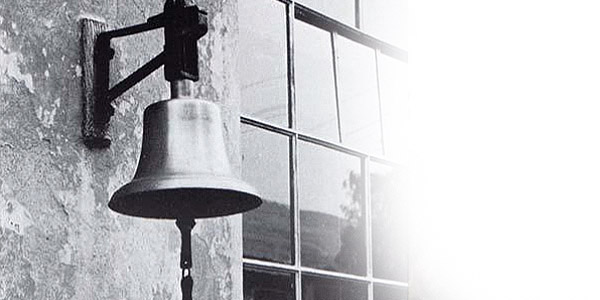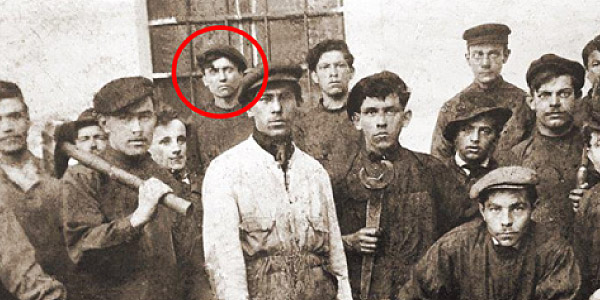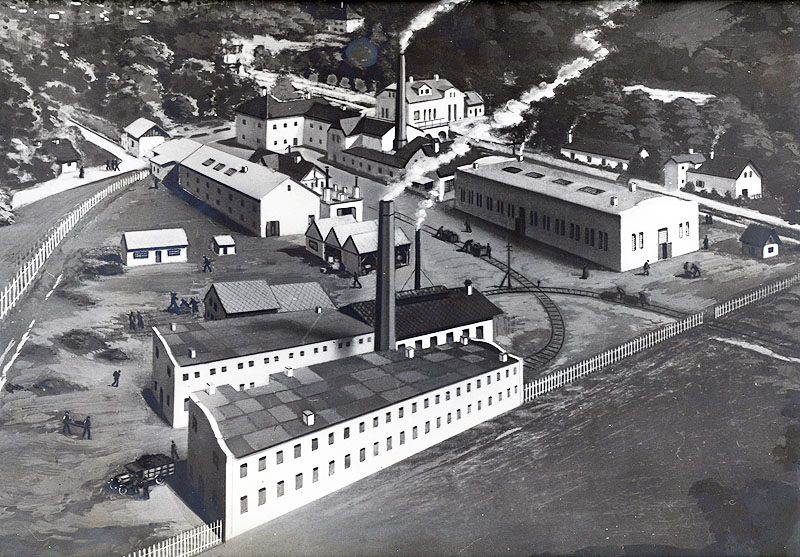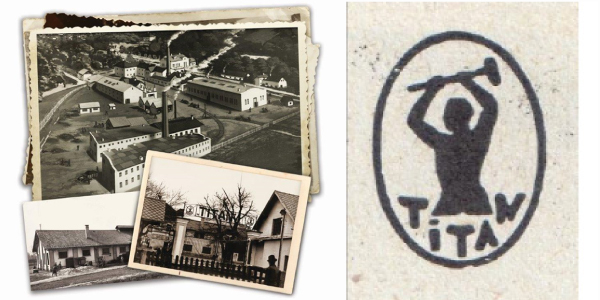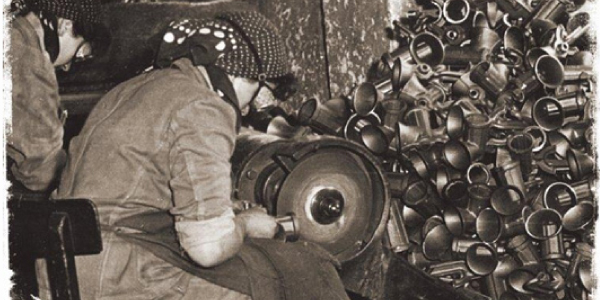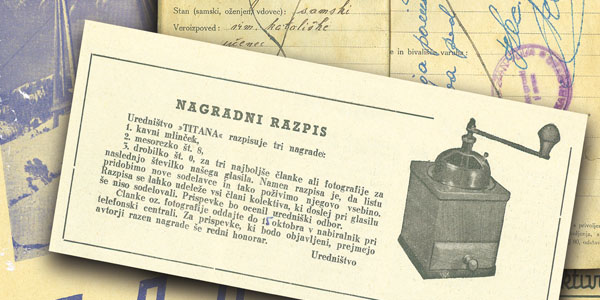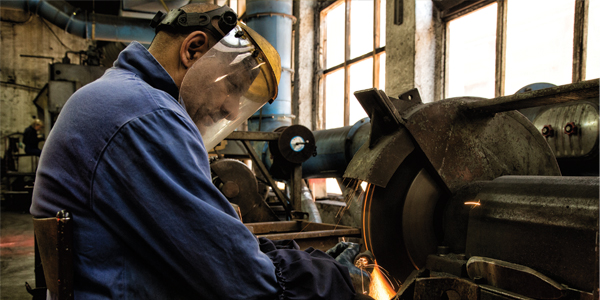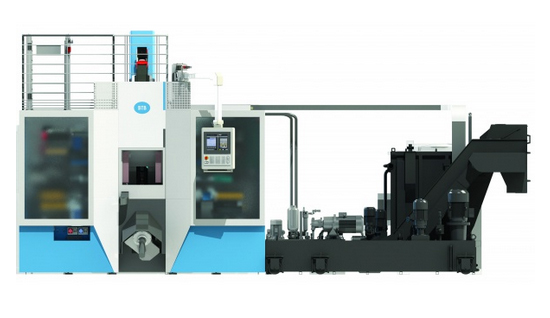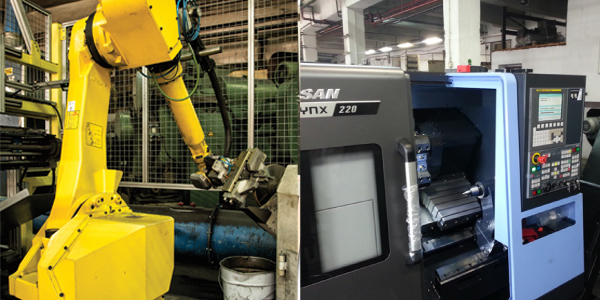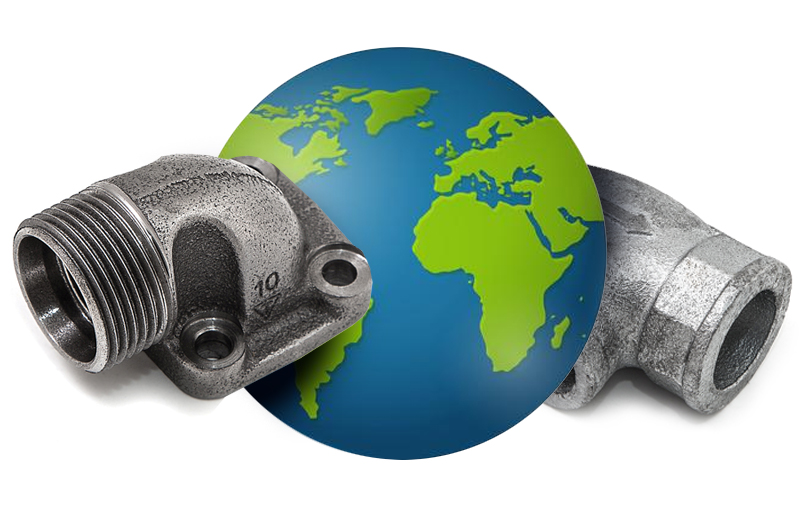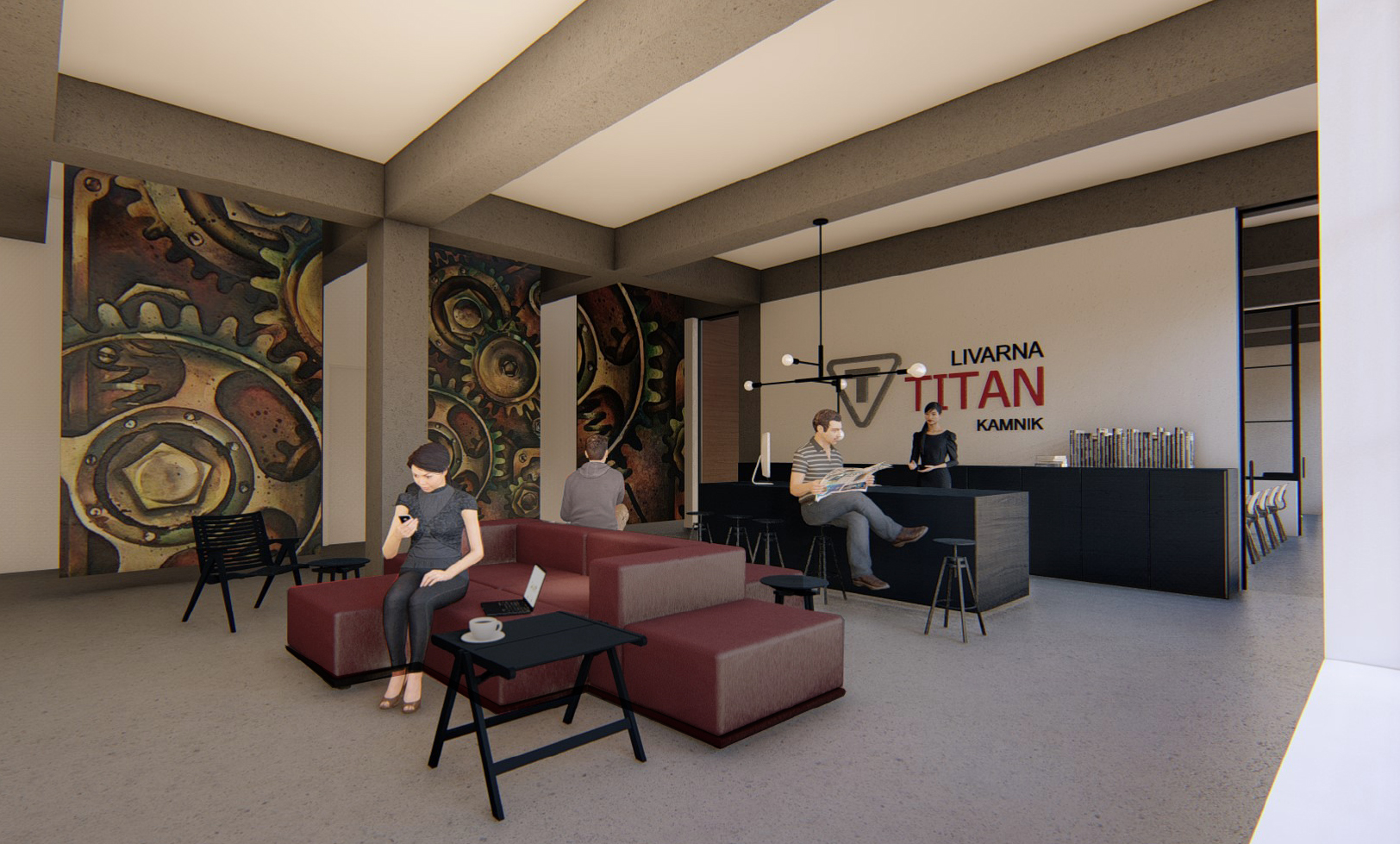The force of water, which was the only source of energy in the 19th century, used to drive many millwheels on the bed of the torrential river Bistrica. The mills ground grain, different cleansing powders, and mineral dyes. On title number 718, where today’s Livarna Titan stands, there was landowner Bučar’s mill producing mineral dyes. He sold his possession together with the mill to Czech engineer Špalek who, in 1896, started cottage industry of metal parts. Getting married to a wealthy bride of Austrian origin enabled him to increase production fairly rapidly:
• heavy and light surface-mounted locks,
• mortised locks,
• and long and short door hinges.
Thus, the year 1896 can be considered the beginning of Titan. Špalek’s bell, the factory bell (restored in 1939), which clanged the workday, remained engraved in the memories of the workers of those days. Best known is Špalek’s quote: “As long as this bell clangs, order will be maintained in this factory.”
In 1911, Josip BROZ, who later became president of the Socialist Federal Republic of Yugoslavia, and was named Marshall TITO, got a job in the factory as a locksmith, and so he spent a few months in Kamnik. He was a member of the trade union. As a good gymnast, he was a member of the SOKOL movement which was a national pro-Yugoslav and anti-Austrian gymnastics organization. Josip BROZ stayed in Kamnik until May 1912. In that period, the factory was owned by a listed company from Vienna. When it went bankrupt, it had to be closed down. The workers were laid off. Out of approximately 150 workers some ten received recommendation to work in Bohemia. Josip BROZ was one of them. Upon arriving to Jeničenkov, to a big factory of metal products, the plan was to use the workers as strike-breakers, to which they opposed in unison. Moreover, they achieved that the Czech workers – and they themselves – received a pay rise.
In 1922, the ownership of the factory changed again. It was taken over by a new listed company from Zagreb, establishing “Kranjske tvornice željezne i bravarske robe TITAN d.d. u Zagrebu”. The factory expanded again, an own power station was set up, and departments for automatons and the assembly of kitchen appliances were devised. In 1925, they were incorporated into the company “Osječka ljevaonica željeza i tvornica strojeva”.
Upon the takeover of the factory in the same year, the idea of creating a logo emerged, and so the name “TITAN”, which is still used, was created. The logo showed a door and a giant, who was trying to pull the lock out of the door. Somebody shouted: “This is a TITAN!” The word was catchy enough to become the brand name, and to survive to the present day, while the logo was changed later on.
Titan achieved huge progress in the years from 1933 to 1939. In 1933, the assortment was changed fundamentally: the production of iron stoves and different steel products was abandoned, while the production of fittings, scales, poppy seed grinders, meat grinders, cartridge cases, rifle ornaments, nuts, cabinetmaking tools, scale pans, crushers, brass weights, different kitchen appliances and furniture locks was started. Some products were even exported: locks to Palestine and Italy; besides locks also different mountings.
In the foundry, the old cupola furnace was replaced by two new ones, and a chamber furnace for tempering was added. After 1936, the labour movement picked up again. The “Jugoslovanski stručni savez” and soon after that, the “Savez metalskih radnika” – both parties of workers in the metal industries – were established. The latter was headed by Franc LESKOVŠEK – Luka, who was employed as a lathe turner at TITAN.
On 13 May 1941, when the Germans occupied Kamnik, they took over Titan, too. The first casualties of the German occupation were two Titan workers – Dominik Mlakar, a moulder in the foundry, and the locksmith Anton Miklavčič.
In 1943, Titan was sold again – this time to the Austrian company »Kärntner Maschinenfabrik« in Villach – and manufacture was converted to war production. The new name of the firm was Titan AG. They produced metal parts for gas masks, some parts for machine guns, horseshoes for oxen, and towards the end of the occupation, they even cast mine housings for mortars. The company was protected by a barbed wire fence and bunkers. There was a continuously manned police station within the company area protecting the facilities from partisan diversion.
In the liberation war, 27 workers of Titan gave their lives. At that time, it meant 10% of all employees. Many workers were active in the field supporting the NOB – the liberation war.
When the war was coming to an end, overflights of allied planes and air alarms caused many interruptions in production. The workers waited for the end of the alarm in the nearby woods, later air-raid shelter inside the company was built.
Productivity was low, as the Germans did not invest much in the plant. The tool makers received two electrical drawbars and a drilling machine. A machine for testing hardness is from that time, too. In the foundry, the methods of work and technology did not change. Linings were rammed only manually on turn table machines. The Germans were not keen on modernising the factory, they only tried to get the most out of it.
And then 9 May came – liberty day. The factory employed only 256 workers. The first wages after the war were financed by selling gas mask housings and horseshoes for oxen – the remains of war production.
After the liberation in May 1945, the factory was nationalised, first under PR of Slovenia, and later the FPR of Yugoslavia. However, the first director in the socialist state was an expert – engineer Leopold Andree, assistant of mechanical engineering at the Technical faculty, and later a professor at the Faculty of mechanical engineering. After the war, production of fittings, locks and household appliances resumed. The factory was nationalised during the first nationalisation.
Industrialisation in the broader sense started in the post-war period. There was neither qualified staff nor necessary know-how. Titan had to obtain this by itself. In 1952, a pewter mill, galvanisation, foundry of malleable cast and a cleaning plant for casts was built. The existing facilities were expanded and refurbished. In 1949, a special vocational school for locksmiths was established to facilitate the needs of the factory. In 1951, it was closed down, and its activities were relocated to Litostroj’s school. The school building next to the factory was transformed into a block of flats to house factory workers. As late as in 1976, unknown authors wrote in Titan’s jubilee publication: “The worker has become the fourteenth and last owner in the history of Titan.”
At the end of the sixties, Titan started production of ski bindings in cooperation with Tyrolia.
Today, Livarna Titan is a successful company competing in an increasingly demanding international market. The last five years were a period of huge changes for Livarna TITAN. Favourable external macroeconomic factors and huge effort, which was made within the company, made it possible that, in that period, Livarna Titan succeeded in increasing sales, profit and value added per employee year after year. Such an improvement was facilitated by numerous activities aimed at improving working conditions, health and safety of workers in the workplace and risk prevention.
The majority of investments was made on the shop floor, which resulted in lower costs, less discard and more stable quality. Investments at that time facilitated less congestion and more profitable operations (higher customer satisfaction, fewer complaints, etc.). SAP’s IT system played a crucial role in optimising business processes, since it enables total production traceability.
In 2010, Drago Brence took over management of the company, and in the next four years he paved the way for the first positive result.
The formula for success was simple: cutting costs, increasing sales and paying attention to cash flow, which, of course, required a lot of effort, perseverance and, last but not least, a change in the mindset and culture of the company.
After 2010, the company decreased loss every year, and it started refurbishing the premises, investing in new equipment, but in the first place, the emphasis was on optimising business processes, reducing discards and monitoring productivity.
In 2014, the foundry changed ownership again. Hundred per cent ownership was acquired by the then director of the company. The foundry became a family-run business, and it was renamed Livarna TITAN d.o.o.
In 2015, the company adopted the strategical plan for 2015 – 2020 in which the key goals were set, and which proved that the specified direction was correct.
Livarna TITAN exports castings to over 40 countries all over the world, which represents about 90% of its annual turnover. In the key segment of fittings, the company is entering new markets with the help of local, specialized distributers, who are logistically capable of supplying the whole market of their country. Specialised fairs, e.g. ISH in Frankfurt, Aquatherm in Moscow and MCE in Milan, have proved the best way of finding business partners. Besides this, a century long tradition and a recognisable brand play a crucial role when entering new markets, as business partners are often familiar with the products of the company, and they decide to make contact by themselves when they wish to cooperate.
Livarna TITAN exhibits social responsibility primarily by encouraging young people in their career; this is the reason for sponsoring the event “Skok čez kožo”, where miners, metallurgists and geologists, who have already finished their studies, affiliate senior students.
Hundred years of foundry operations at TITAN coincide with another important anniversary. In order to draw attention to the often-overlooked role of metallurgy in the public, colleagues at the National Museum of Slovenia and the Department of Materials and Metallurgy of the Faculty of Natural Sciences and Engineering in Ljubljana joined forces on the occasion of the 100th anniversary of the University of Ljubljana. The aim of the exhibition project »The Song of Metal« is to draw attention to the rich technical heritage, which is unfortunately not known well enough, and which has been systematically collected by the National Museum of Slovenia over almost two centuries of the institution’s existence.
Among the displayed items, products of Livarna TITAN, who – as a bronze sponsor – supports the exhibition and promotion of metallurgy in Slovenia, can be found. At the exhibition Livarna TITAN displays the so-called Tee fitting in different stages of treatment as well as a corebox with a core.
The overall presence of metals in high-technology products in all areas of human activities results in the metal industry and related areas being one of the strongest technological sectors in the European Union. The combination of primary production of metals, the manufacture of alloys, and the technological procedures, which include metal products and their recycling, accounts for almost half of all generated value in the EU, and more than one-tenth of the whole GDP. So, what does it need to develop as an industry of the future?
From the historical point of view, Europe has always been a big player in metallurgy, which has a multi-thousand-year history on European soil. Metals and alloys, which are produced here, are used in a wide range of high-technology products like aeroplanes, vehicles, trains, ships, satellites, propulsion systems, turbines, batteries, fuel cells, catalytic reactors, wind turbines, magnets, electrical cables, pipelines, robots, orthopaedic appliances, computers, mobile phones, and other products. We cannot image the modern world without metal materials.
In Slovenia’s strategy of smart specialisation S4, a plan of the Republic of Slovenia for the transition to a highly-productive economy by strengthening innovative capacity, encouraging transformation and diversification of industries into new sectors, and the growth of emerging companies, the production of metals and metal products is identified
as crucial, and thus a priority industry.
The significance of the metalworking chain in Slovenia is best illustrated by its share to the number of employees and added value which it generates. One in ten Slovenians are employed in the metalworking chain contributing 8.5% of GDP. Out of all processing activities, it generates 40% of all added value employing a similar number of people. The metalworking chain is extremely export oriented, since it generates two thirds of its sales revenues in foreign markets.
All presented data highlight the important role of the metalworking industry and metallurgy in Slovenia, in which Livarna TITAN has still a lot of alternatives and potential for its development in the coming years.
As a result, the basic emphasis of Livarna TITAN’s new strategy for the period 2020 – 2025 will put on new investments:
- Industry 4.0, which will be achieved with the introduction of automatization and robotization of production, represents a transformation to the so-called smart factory in such a way that processes, procedures, products and machines will be connected and ready to communicate with each other; later they will be able to cooperate with people as well (robots will be able to cooperate with people), which will lead us to the so called industry 5.0.
Consequently, new investments will lead to an increase in productivity, competitive advantage and higher added value, which will be the basic strategical goal for the 2020 – 2025 period.
